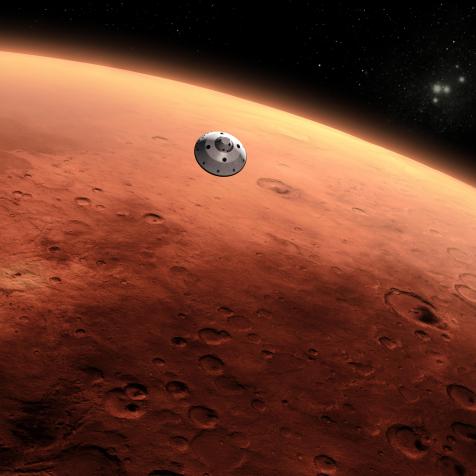
NASA/JPL-Caltech
New Photos of Martian Space Wreckage
NASA's Ingenuity helicopter captured photos of an eerie debris field on Mars.
This month, Ingenuity– NASA’s small robotic helicopter– captured images of a mysterious wreckage.
The new photos, taken from overhead, reveal an eerie scene– crashed space debris amidst the desolate Mars landscape. Some speculated the wreckage was from an alien spaceship.
NASA clarified this debris is actually from a NASA landing device. More specifically, the parts that were used to safeguard the Preservarance rover during its landing on Mars in February 2021.

Tony Greicius
This illustration depicts Mars Helicopter Ingenuity during a test flight on Mars. Ingenuity was taken to the Red Planet strapped to the belly of the Perseverance rover (seen in the background).
The broken parts, seen strewn across the red planet in Ingenuity’s photos, include a parachute and cone-shaped backshell, which protected Preserverance during its fiery descent on Mars’ surface.
The $2.5 billion rover landing is often referred to as “7 minutes of terror” because the process happens faster than radio signals from Mars can reach Earth– meaning the landing has to happen without the help of mission control.

NASA/JPL-Caltech
Engineers working on the Mars Sample Return program requested images be taken of the components from an aerial perspective because they may provide insight into the components' performance during the rover's entry, descent, and landing.
The rover’s descent on Mars isn’t just a stress-inducing seven minutes for the scientists, themselves, but for the robots too. Landing on this dusty planet involves navigating extreme temperatures comparable to the heat on the sun’s surface, while also trying to land in the right place.
"I don't think I'm exaggerating when I say that entry, descent, and landing (EDL) is the most critical and most dangerous part of the mission," said Allen Chen, the EDL lead, during a news conference. "Success is never assured, and that's especially true when we're trying to land the biggest, heaviest, and most complicated rover we've ever built to the most dangerous site we've ever attempted to land on."
The rover’s backshell impacted Mars’ surface at 78 miles per hour, but the images reveal that its protective coating and many of its high-strength suspension lines appear to have remained intact. From analyzing the images, scientists believe the parachute's canopy remained unscathed too.

NASA/JPL-Caltech
This artist's concept depicts NASA's Mars 2020 rover on the surface of Mars.
The mission takes the next step by not only seeking signs of habitable conditions on Mars in the ancient past, but also searching for signs of past microbial life itself.
"Perseverance had the best-documented Mars landing in history, with cameras showing everything from parachute inflation to touchdown," said Ian Clark, former Perseverance systems engineer. "But Ingenuity's images offer a different vantage point. If they either reinforce that our systems worked as we think they worked or provide even one dataset of engineering information we can use for Mars Sample Return planning, it will be amazing. And if not, the pictures are still phenomenal and inspiring."
NASA’s researchers will continue to analyze the images over the coming weeks to help improve future exploration on Mars.


















